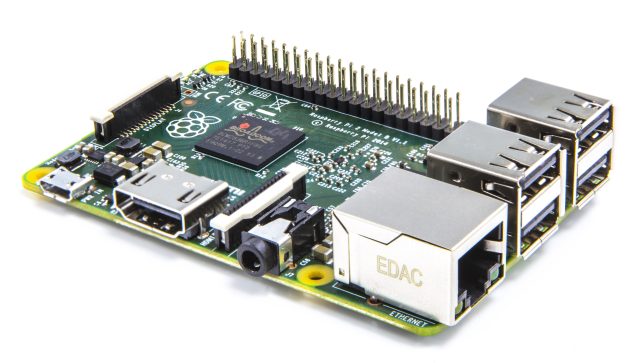
Three years after the launch of the first Raspberry Pi, second generation hardware will go on sale today for the same $35 price while offering a lot more power.
The nonprofit Raspberry Pi Foundation has sold 4.5 million of the small computers. "It's a few more than we expected," Raspberry Pi creator Eben Upton told Ars.
The new "Raspberry Pi 2" has roughly the same form factor as the $35 Model B+ from July 2014, which changed the appearance by doubling the number of USB ports to four, adding more GPIO pins, and replacing the SD card slot with a MicroSD one.
But the Model B+ had the same processor as the original released in 2012. Raspberry Pi 2 earns its "2" with upgrades to the CPU and memory. The GPU is unchanged.
The new Pi has a quad-core processor that runs at 900MHz, compared to a single-core CPU that ran at 700MHz in the first generation. It's also an ARMv7 processor rather than an ARMv6 processor, which limited the software available on the original hardware.
Raspbian, a version of Debian compiled for the original Pi’s processor, will make another appearance on Raspberry Pi 2, but the ARMv7 processor should also allow volunteers to bring Ubuntu and other OSes to the hardware.
The new Pi will have 1GB of RAM, double the previous version. You'll be able to find links to distributors selling the new Pi at the Raspberry Pi website.
Raspberry Pi 2 is a “Model B,” though there is no Model A yet for the second generation hardware. Model A from the first generation will still be available.
“The current Raspberry Pi Model A+ is $20. We don't know yet when that will be updated. We suspect it will get a RAM upgrade (256->512MB) before a processor upgrade. Keeping the price low is the priority,” Raspberry Pi evangelist Matt Richardson told Ars.
Here is the full list of specs for Raspberry Pi 2 Model B:
- SoC: Broadcom BCM2836 (CPU, GPU, DSP, SDRAM)
- CPU: 900 MHz quad-core ARM Cortex A7 (ARMv7 instruction set)
- GPU: Broadcom VideoCore IV @ 250 MHz
- More GPU info: OpenGL ES 2.0 (24 GFLOPS); 1080p30 MPEG-2 and VC-1 decoder (with license); 1080p30 h.264/MPEG-4 AVC high-profile decoder and encoder
- Memory: 1 GB (shared with GPU)
- USB ports: 4
- Video input: 15-pin MIPI camera interface (CSI) connector
- Video outputs: HDMI, composite video (PAL and NTSC) via 3.5 mm jack
- Audio input: I²S
- Audio outputs: Analog via 3.5 mm jack; digital via HDMI and I²S
- Storage: MicroSD
- Network: 10/100Mbps Ethernet
- Peripherals: 17 GPIO plus specific functions, and HAT ID bus
- Power rating: 800 mA (4.0 W)
- Power source: 5 V via MicroUSB or GPIO header
- Size: 85.60mm × 56.5mm
- Weight: 45g (1.6 oz)
Here are a few more views of the new device:
-
Raspberry Pi Foundation
-
Raspberry Pi Foundation
-
Raspberry Pi Foundation
-
Raspberry Pi Foundation
-
Raspberry Pi Foundation
-
The Raspberry Pi 2, which will run Windows 10, or at least, a version thereof.Raspberry Pi Foundation
New Raspbian operating system images will also be released today. “They'll be compatible with either the Raspberry Pi or the Raspberry Pi 2,” Richardson said. “People with SD cards that already have Raspbian on them will be able to update (only from their original Raspberry Pi) so that their Raspberry Pi 2 can boot them. They'll need to use apt-get upgrade.” The one catch is that people moving from the earliest Pi versions will have to get the image onto a MicroSD card instead of a standard-sized SD card.
Getting a Pi when they first came out was difficult due to demand that far outstripped supply. The supply chain has gotten better, with the ability to build many tens of thousands a week, mostly at a Sony factory in Wales, Upton told Ars. Upton expects more than 100,000 to be ready for today's on sale date. They'll probably have to keep pumping them out, though; the foundation is still selling about 200,000 of the older Raspberry Pi computers a month.
The greater CPU power and memory in Raspberry Pi 2 will surely fuel more creative projects. The original Pi hardware was used to build robots, arcade machines, media centers, a high-performance computing cluster, musical instruments, and many other things. The Pi is also used to teach children how to program.
Upton thinks the newest Pi will be fast enough to use as a basic desktop computer. The second generation should offer smoother Web browsing and the ability to run multiple programs at once without a noticeable slowdown, he said. "We're hoping people could use it as their main PC," he said. "We have people here at the office who use them as their second PC."
UPDATE: It turns out both Ubuntu and Windows 10 will run on the new Raspberry Pi.
"For the last six months we’ve been working closely with Microsoft to bring the forthcoming Windows 10 to Raspberry Pi 2. Microsoft will have much more to share over the coming months," Upton wrote today. "The Raspberry Pi 2-compatible version of Windows 10 will be available free of charge to makers."
The version of Ubuntu available for the Pi is Snappy Ubuntu Core. This version targeted at developers and cloud deployments does not have a desktop interface.
reader comments
202